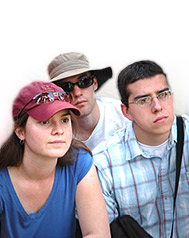About LANL
About Our Capabilities, Facilities, and Staff
"Los Alamos National Laboratory plays an indispensable role in building America as a science and technology powerhouse, and our staff are an incredible resource to the nation and the world." Michael Anastasio, Dir.
Solving Complex R&D Problems with Special Blend of Staff, Capabilities and Facilities
Now in its seventh decade, LANL remains among a very few laboratories that can bring great breadth of fundamental and discovery science, technology, and engineering rapidly together to create tangible solutions for national security needs.
Our staff, working with partners throughout science and industry, must be able to deliver today's solutions while maintaining the depth of capabilities to deliver the next generation of discoveries.
Los Alamos has demonstrated a cycle of innovation where we have developed world-leading capabilities and facilities in response to urgent, unique missions. We also spin out new discoveries that lead to emerging missions.
Being able to integrate and apply our capabilities rapidly to new challenges will be a key advantage in an increasingly competitive landscape.
Our Science, Technology and Engineering Priorities
Science that Matters
- Information science and technology enabling integrative and predictive science
- Experimental science focused on materials for the future
- Fundamental forensic science for nuclear, biological, and chemical threats
How We Work
- Collaborate, partner and team to make decisive contributions to our sponsors
- Outstanding operational excellence for safety, security, and efficient pursuit of ST&E for our missions
Transform Our Scientific Campus
- Campus for 2020 (consistent with complex transformation)
- Modern science facilities: LANSCE refurbishment, CMR replacement, Science Complex
- Signature facilities for experimental science (MaRIE) and computational science (Roadrunner)
More About This Science
Tunable Diode Laser (TDL) Techniques On Open-leaf Gas-exchange Systems
Early Climate Change Detection
Scientists' new plant research could prevent ecological collapse

Quick read
Scientists' novel plant monitor measures climate impacts and creates early-warning system to prevent ecological collapse.
LANL scientists and collaborators work to measure global climate change at plant tissue level, creating an early warning system that could prevent ecological collapse.
Researchers developed a method for constantly measuring climate change impacts at ecosystem scales using the stable isotope composition of atmospheric carbon dioxide (C02) in plants.
In research published recently in the journal Plant, Cell & Environment, Los Alamos scientist Nate McDowell and his team described how they used tunable diode laser (TDL) techniques on open-leaf gas-exchange systems on plants to make the first continuous, high-precision isotopic flux measurements at the tissue scale. These foliar isotope fluxes have allowed the researchers to discover new insights in plant carbon metabolism and foliar water/CO2 interactions. Their work is a first step toward unraveling the important climate impact signals carried in atmospheric CO2.
The TDL instrument allows assessment of these signals continuously (every minute) by measuring atmospheric CO2. When coupled with high-performance computer models, the monitoring allows researchers to forecast imminent vegetation stress in response to drought and other environmental factors.
In the course of developing the TDL technique, McDowell's team has produced the first and only long-term data set (three years) of continuous measurements of the isotopic CO2 exchange between a terrestrial ecosystem and the atmosphere. This unique data set is already providing novel insights into how climate impacts ecosystem metabolism.
Laser-based methods are being considered for use by the National Science Foundation as an early warning system as part of its NEON (National Ecological Observatory Network) initiative. The carbon isotope patterns detected result largely from plant water stress, while the oxygen isotopes carry a signature of the water cycle.
In addition to McDowell, other members of the TDL device development team include Heath Powers of Los Alamos National Laboratory, Margaret Barbour of Landcare Research in New Zealand, Guillaume Tcherkez of the Laboratoire d'Ecophysiologie Végétale in France, and Christopher Bickford and David Hanson from the University of New Mexico.








